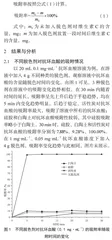脱色剂对2,6-二氯靛酚滴定法测定抗坏血酸含量的影响
作者: 王文宇 郭彬 阎小青

作者简介:王文宇(2003—),女,山西长治人,本科在读。研究方向:食品理化检验。
通信作者:阎小青(1983—),女,山西太原人,博士,副教授。研究方向:样品前处理。E-mail: yanxiaoqing83@163.com。
摘 要:目的:探究2,6-二氯靛酚滴定法中脱色剂对抗坏血酸含量的影响,为脱色剂的正确使用提供指导。方法:采用3种常用脱色剂白陶土、硅胶、活性炭,分析脱色剂用量和脱色时间在不同浓度抗坏血酸溶液中对抗坏血酸吸附的影响,并选择深色水果脐橙和浅色水果猕猴桃加以验证,对脱色条件进行优化。结果:3种脱色剂均对抗坏血酸具有吸附作用,吸附能力排序为活性炭>>白陶土>硅胶。在高浓度抗坏血酸溶液中(1 mg·mL-1),白陶土和硅胶用量的变化对抗坏血酸吸附率无显著影响。而在低浓度抗坏血酸溶液中(0.1 mg·mL-1、0.05 mg·mL-1),吸附率随脱色剂用量的增加而增加,30 min时白陶土抗坏血酸吸附率为6.92%~23.32%,硅胶抗坏血酸吸附率为7.88%~8.82%。活性炭在低浓度和高浓度抗坏血酸溶液中吸附力均最强,30 min时抗坏血酸吸附率在74.17%~100%。在测定水果滤液中抗坏血酸含量时,抗坏血酸吸附率随脱色剂用量的变化趋势和0.1 mg·mL-1抗坏血酸溶液一致,活性炭、白陶土、硅胶的抗坏血酸吸附率分别为64.78%~95.85%、3.32%~13.29%、4.84%~6.63%,且脱色效果排序为白陶土>活性炭>硅胶。经优化,每克水果样品白陶土用量0.8 g,脱色时长15 min为最佳测定条件。结论:在使用2,6-二氯靛酚滴定法测定抗坏血酸含量时推荐使用白陶土作为脱色剂,为了减少其对抗坏血酸的吸附,在使用时要尽量减少用量和脱色时长。
关键词:2,6-二氯靛酚法;脱色剂;抗坏血酸;吸附率
Effect of Decolourising Agents in the Determination of Ascorbic Acid by Titration with 2,6-Dichloroindophenol
WANG Wenyu, GUO Bin, YAN Xiaoqing*
(School of Public Health, Shanxi Medical University, Taiyuan 030001, China)
Abstract: Objective: To investigate the effect of decolourising agents on the determination of ascorbic acid with 2,6-dichloroindophenol titration method, and to provide guidance for the correct use of decolourising agents. Method: Three commonly used decolorants, white clay, silica gel and activated carbon were selected, and the effects of their decolorant dosage and decolorization time on the adsorption of ascorbic acid in the ascorbic acid solutions with different concentrations were anlyzed. The dark-colored fruits of navel oranges and light-colored fruits of kiwifruit were selected for validation, and the conditions of the decolorization were optimized. Result: All three decolourising agents adsorbed ascorbic acid, and the adsorption capacity was ranked as follows: activated carbon was much larger than white clay and larger than silica gel. In the high concentration of ascorbic acid solution (1 mg·mL-1), there was no significant difference in the adsorption rate of ascorbic acid using different dosage of white clay and silica gel. While in the low concentration ascorbic acid solution (0.1 mg·mL-1, 0.05 mg·mL-1), the adsorption rate increased with the increase in the amount of adsorbent, ranging from 6.92% to 23.32% for different dosages of white vitrified clay and 7.88% to 8.82% for silica gel when adsorbed for 30 min. Activated carbon was strongly adsorbed ascorbic acid in both low and high concentration ascorbic acid solutions, with adsorption rates ranging from 74.17% to 100% when adsorbed for 30 min. In the determination of ascorbic acid content in the fruit filtrate, the trends of ascorbic acid adsorption rate varied with the dosage of the three decolourants were consistent with that in the 0.1 mg/mL ascorbic acid standard solution. The adsorption rates for ascorbic acid of activated carbon, white vitrified clay and silica gel in the fruit filtrate ranged from 64.78% to 95.85%, 3.32% to 13.29% and 4.84% to 6.63%, respectively. The decolourisation effect is ranked as follows: white clay is better than activated carbon and better than silica gel. The dosage of white clay was optimized to be 0.8 g/per gram of fruit and the duration of decolourisation was
15 min. Conclusion: White clay is recommended as a decolourising agent for the determination of ascorbic acid content using 2,6-dichloroindophenol titration, and in order to reduce the adsorption of ascorbic acid, it should be used in the minimum possible dosage and decolourisation duration.
Keywords: 2,6-dichloroindophenol method; decolorant; ascorbic acid; adsorption rate
维生素C是一种水溶性维生素,也称为抗坏血酸,是人体必需的营养物质之一。维生素C具有抗氧化、促进铁吸收、增强免疫力等多种作用。果蔬中抗坏血酸含量是判断果蔬营养价值的重要指标之一。食品中抗坏血酸的测定方法有很多,《食品安全国家标准 食品中抗坏血酸的测定》(GB 5009.86—2016)[1]中第一法为高效液相色谱法,第二法为荧光法,第三法为2,6-二氯靛酚法。其中,2,6-二氯靛酚法利用抗坏血酸的还原性对其进行氧化还原滴定,操作简单、试剂价格便宜、精密度和准确度高且不需要大型分析仪器设备,广泛用于水果、蔬菜及其制品中抗坏血酸的测定[2]。在测定过程中,由于果蔬的颜色会影响滴定结果的观察,需要进行脱色处理。国家标准方法中建议使用白陶土对果蔬进行脱色,但对脱色时间无具体说明,只是标明白陶土对抗坏血酸无吸附。但是,有文献报道白陶土对抗坏血酸的吸附作用较强[2-8],也有文献表明白陶土脱色效果不佳,应选择活性炭作为吸附剂[4-5]。
笔者推测之所以产生这些相互矛盾的结论是各个文献报道中所采用的水果种类、抗坏血酸浓度以及脱色剂种类、用量和时间不一致造成的[9-11]。因此,本研究分别考察了白陶土、硅胶、活性炭3种常用脱色剂在不同用量和脱色时间下对不同浓度的抗坏血酸溶液的吸附影响,并对深色水果脐橙和浅色水果猕猴桃的脱色效果和抗坏血酸吸附情况进行了探讨。希望本试验能为脱色剂的正确使用提供指导。
1 材料与方法
1.1 材料与仪器
猕猴桃(产地为陕西省西安市周至县);脐橙(产地为江西省赣州市);草酸(分析纯,天津市风船化学试剂科技有限公司);2,6-二氯靛酚钠盐水合物(上海麦克林生化科技股份有限公司);抗坏血酸(分析纯,天津市大茂化学试剂厂);碳酸氢钠(分析纯,天津市大茂化学试剂厂);白陶土(天津市大茂化学试剂厂);硅胶(安捷伦科技有限公司);活性炭(天津市大茂化学试剂厂)。
ES-J220型电子天平(天津市德安特传感技术有限公司);榨汁机(苏泊尔倍爱系列)。
1.2 试验方法
1.2.1 2,6-二氯靛酚(2,6-二氯靛酚钠盐)溶液的配制及标定
相关操作步骤同GB 5009.86—2016[1]。
1.2.2 不同脱色剂的用量随时间对不同浓度抗坏血酸吸附试验
分别取20 mL 1 mg·mL-1、0.1 mg·mL-1和
0.05 mg·mL-1的抗坏血酸溶液于50 mL烧杯中,依次加入0 g、1 g、2 g、4 g及6 g的白陶土、硅胶和活性炭,用玻璃棒充分搅拌后静置5 min、10 min、15 min、20 min、25 min及30 min,滤纸过滤,采用2,6-二氯靛酚滴定法测定滤液中抗坏血酸的含量,重复3次。
1.2.3 果蔬中维生素C含量的测定
猕猴桃和脐橙去皮,切成小块,除去不能食用部分,分别称取125 g猕猴桃和脐橙,放入粉碎机中,加入100 mL 2%草酸溶液,迅速搅成匀浆,将匀浆液转移至1 000 mL容量瓶中,加入2%草酸定容至刻度线,摇匀后用尼龙纱布过滤,分别量取20 mL滤液至烧杯中,依次加入0 g、1 g(GB 5009.86—2016要求每克样品加0.4 g白陶土[1],20 mL滤液折合原料2.5 g,因此加入1 g白陶土即为国家标准用量)、2 g、4 g、6 g的白陶土、硅胶和活性炭,用玻璃棒充分搅拌后静置15 min,过滤。观察比较各种脱色剂对匀浆液的脱色效果,然后取上述滤液用标定过的2,6-二氯靛酚溶液进行滴定,重复3次。
1.2.4 吸附率计算
吸附率按照公式(1)计算。
(1)
式中:m0为未加入脱色剂时维生素C的含量,mg;m为加入脱色剂放置一段时间后维生素C的含量,mg。
2 结果与分析
2.1 不同脱色剂对抗坏血酸的吸附情况
以20 mL 0.1 mg·mL-1抗坏血酸溶液为例,在溶液中加入4 g不同种类的脱色剂,观察溶液中抗坏血酸的含量随脱色时间的变化。由图1可见,3种脱色剂在溶液中的吸附变化趋势相似,在30 min内随着时间的延长,吸附率呈先上升后趋于平稳趋势,均在
5 min内变化趋势明显,后趋于稳定。活性炭对抗坏血酸的吸附率最大,吸附了溶液中所有的抗坏血酸;硅胶和白陶土对抗坏血酸吸附性较弱,其中硅胶吸附率略小于白陶土。30 min时,硅胶、白陶土和活性炭对抗坏血酸的吸附率分别为7.88%、9.28%、100.00%。在1 mg·mL-1、0.05 mg·mL-1抗坏血酸浓度下加入
4 g脱色剂,吸附率变化趋势与此相同,图片未展示。
图1 不同脱色剂对抗坏血酸(0.1 mg·mL-1)的吸附率随吸附时间的变化
2.2 脱色剂用量对不同浓度抗坏血酸吸附的影响